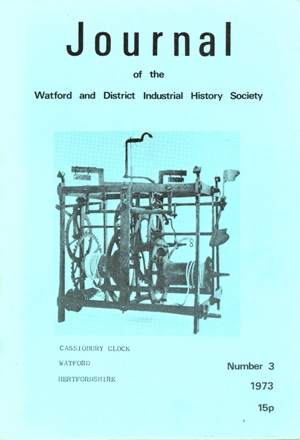 Review
of an early Journal
Review
of an early Journal| WADIHS |
Watford and District |
An active historical society with an interesting programme of meetings and outings and a journal which records some of the very interesting talks.
See its web site for the current programme and a list of the articles in the past issues of the Journal.
Journal of the Watford and District Industrial History Society
Number 3: 1973
| CONTENTS | ||
| R J Beattie | Building of Watford to St Albans Railway | |
| K J Ming | Clocks and Clockmakers | |
| L C Johnson | British Transport Commission Archives | |
| J G Dony | Straw Plaiting Industry of Hertfordshire and Bedfordshire | |
| P Walne | County Archives and their use | |
| G B Harrison | Some Aspects of Coal and Coal Mining | |
| Building of Watford to St Albans
Railway A very interesting account of the trials and tribulations of building this short line. It was authorised in 1853 and, after difficulties with the contractor, opened in 1858. The station at Bricket Wood opened in 1861 and the one at Park Street opened in 1890. The Station at Bricket Wood à |
||
| Clocks and Clockmakers A general talk, with pictures, of the history of clocks - including specific details of the Cassiobury clock - which was built somewhere between 1400 and 1600 and whose makers mark was a shell. There is also a mention of John Chapman, of Watford who made clocks in the first half of the 19th century. |
The first type of mechanical clock was recorded circa 1250 but we know nothing of its inventor and the clock did not look like that we know today as it had no dial. Early clocks were used to strike bells to tell the hours and the dial was not linked to the mechanism until much later. A much later example of this clock is the Cassiobury Clock. A picture of clock from Cassiobury the estate of the Earls of Essex until it was demolished in the 1920's is reproduced on the cover of this Journal. The clock still in working order, is preserved in the British Museum and it is notable for the fact that the foliot and verge mechanism are the earliest surviving. The driving power being provided by the weights hanging below the clock and the ropes holding them being wrapped round small barrels at the top of the structure. Time keeping was carried out by a train of gears on the right hand side of the clock and the striking mechanism by the gears on the left hand side. The time keeper itself is a device right at the top of the construction known as the foliot and just below it the verge escapement. The mechanism was so constructed that its crown wheel pushed a vertical rod, the verge, first one way and then the other by pushing on a pallet top and bottom. A horizontal bar, the foliot, was attached to the top of the other vertical rod. This elementary method of timekeeping formed the basis of clocks and watches from circa 1250 to 1650. |
|
|
Straw Plaiting Industry of Hertfordshire and Bedfordshire An interesting talk, with illustrations of the equipment used which is based on Dr. Dony's book A History of the Straw Hat Industry. The two talks on archives both contain interesting examples of material in the archives of relevance to Watford History. |
There is a general point to be made about publications of this type. Some talks will be based on existing more detailed accounts (such as the talk by Dony), but may include additional points directed at the interests of the society being addressed. Other talks may contain original researched material which is not published elsewhere. My advice is that if you are visiting a local studies library it is worth looking at back numbers of such journals to see it there is anything of particular interest.
Page created August 2008